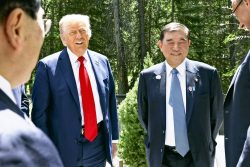G7 Leaders’ Visit to Hiroshima Peace Memorial Museum Realized Due to Kishida’s Wish to Share Grim Reality

Group of Seven leaders walk out of the Peace Memorial Museum with Hiroshima Mayor Kazumi Matsui and Prime Minister Fumio Kishida as part of the G7 Hiroshima Summit in Hiroshima on Friday.
18:45 JST, May 19, 2023
A visit to the Hiroshima Peace Memorial Museum by Group of Seven leaders was made possible by Prime Minister Fumio Kishida’s strong desire to make it happen. Amid growing concerns about the use of nuclear weapons in light of Russia’s invasion of Ukraine, he thought it was essential for G7 leaders to share the reality of the atomic bombing.
Seven years after Barack Obama became the first sitting U.S. president to visit Hiroshima, another step was taken in the history of the atomic bombed city.
On Friday morning, the prime minister greeted U.S. President Joe Biden and other nations’ leaders in turn at the Hiroshima Peace Memorial Park, and then went to the Peace Memorial Museum.
Kishida has been carefully coordinating the leaders’ visit to the Hiroshima Peace Memorial Park since he decided in May last year to hold the G7 summit in Hiroshima, his constituency.
Local residents had expressed the opinion that it was important not only to lay flowers at the Cenotaph for the A-bomb Victims, but also to provide G7 leaders an opportunity to visit the Peace Memorial Museum and listen to the testimonies of atomic bomb survivors.
“How the leaders of various countries think about security and the consequences of the use of nuclear weapons will be different before and after seeing the museum,” Hiroshima Mayor Kazumi Matsui said.
The prime minister has also repeatedly conveyed the message that it is important for the leaders of the world to come into contact with the reality of the atomic bombings.
Since its invasion of Ukraine, Russia has increasingly threatened to use nuclear weapons.
The United States, Britain and France, which also possess nuclear weapons, were wary that if attention were drawn to the U.S. history of dropping atomic bombs, Russia might be able to take advantage of the situation.
The Foreign Ministry made its museum-visit proposal behind the scenes, and received positive reactions from each country.
Yet, even after that, there was a constant exchange of opinions regarding the specifics of the visit, such as the amount of time to be spent in the facility.
The Japanese side hoped that the leaders would take more time to look around the museum than Obama did, a source close to Kishida said.
When Obama visited Hiroshima in May 2016, he spent only about 10 minutes at the museum.
His visit to the museum was not open to the press. According to those who accompanied Obama, he only saw some panels and atomic-bombed artifacts brought into the lobby on the first floor of the east wing of the museum.
Even though Obama had been calling for a “world without nuclear weapons,” he needed to consider the opposition of conservatives and veterans in the United States who claim that more lives were saved by the atomic bombings.
The G7 leaders spent more time in the museum than Obama did during his visit, but media coverage was not allowed inside the museum in consideration to the United States and other countries.
"Politics" POPULAR ARTICLE
-

Japan to Support Central Asian Logistics Route That Bypasses Russia, Plan to Be Part of Upcoming Summit in Tokyo
-

Japan to Tighten Screening of Foreigners’ Residential Status by Providing Information of Nonpayment of Taxes
-

Chinese, Russian Bombers Flew Unusual Path by Heading Toward Tokyo; Move Likely Meant to Intimidate Japan
-

Japan Plans National Database to Track Foreign Ownership of Real Estate, Land as It Weighs New Rules
-

Up to 199,000 Deaths Estimated From Mega-Tsunami; Most Recent Occurrence Took Place in 17th Century
JN ACCESS RANKING
-

Tokyo Economic Security Forum to Hold Inaugural Meeting Amid Tense Global Environment
-

Keidanren Chairman Yoshinobu Tsutsui Visits Kashiwazaki-Kariwa Nuclear Power Plant; Inspects New Emergency Safety System
-

Imports of Rare Earths from China Facing Delays, May Be Caused by Deterioration of Japan-China Relations
-

University of Tokyo Professor Discusses Japanese Economic Security in Interview Ahead of Forum
-

Japan Pulls out of Vietnam Nuclear Project, Complicating Hanoi’s Power Plans
























